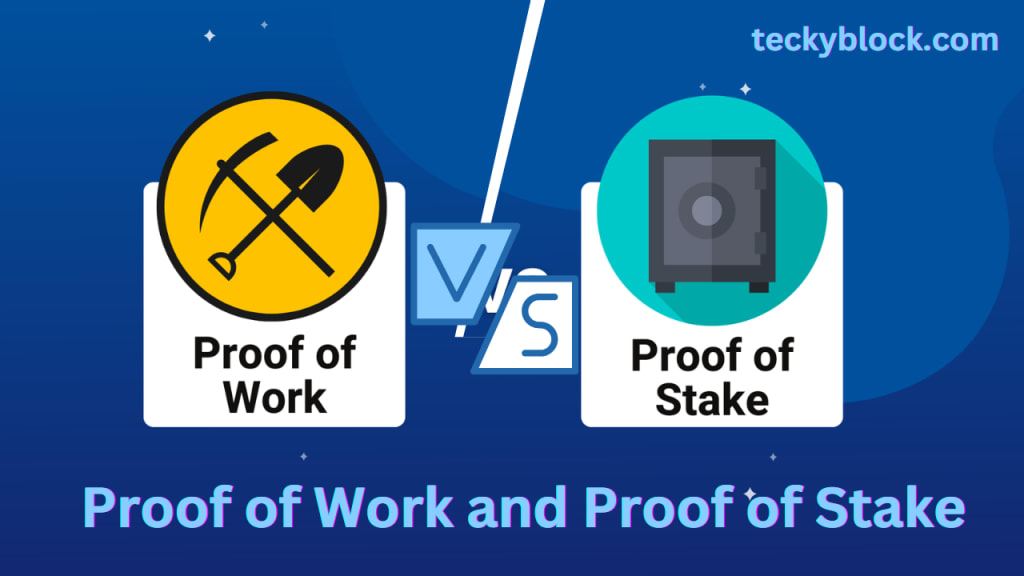Understanding Proof of Work and Proof of Stake: Features, Advantages, and Disadvantages
Explore the concepts of proof of work and proof of stake in cryptocurrency and blockchain technology. Learn about their distinctive features, benefits, and drawbacks. Gain insights into the consensus mechanisms shaping the future of digital transactions.

Introduction
In the fast-evolving world of cryptocurrency and blockchain technology, consensus mechanisms play a pivotal role in ensuring secure and reliable digital transactions. Two prominent consensus mechanisms are Proof of Work (PoW) and Proof of Stake (PoS). In this article, we will delve into the intricacies of PoW and PoS, exploring their definitions, functionalities, and features, as well as the advantages and disadvantages they bring to the table.
I. What is Proof of Work (PoW)?
A. Definition and Purpose of Proof of Work
Proof of Work is a consensus mechanism that requires miners to compete in solving complex computational puzzles to validate and add new blocks to the blockchain. The purpose of PoW is to establish a trustless and decentralized system where participants must demonstrate their computational effort to earn the right to validate transactions.
B. How PoW functions in blockchain networks
In a PoW-based blockchain network, miners utilize their computational power to solve cryptographic puzzles. The first miner to solve the puzzle and validate the block is rewarded with cryptocurrency tokens and transaction fees. The validation process involves verifying the accuracy of transactions and creating a unique hash that connects the new block to the existing blockchain.
C. Features of Proof of Work
PoW exhibits several distinct features that contribute to its functionality and reliability:
- Security: PoW ensures a high level of security by requiring miners to invest computational power, making it extremely difficult to tamper with the transaction history.
- Decentralization: PoW promotes decentralization by allowing any participant with sufficient computational resources to become a miner, preventing the concentration of power in a few hands.
- Consensus: Through the consensus achieved via PoW, participants agree on the validity of transactions and the order in which they are added to the blockchain, establishing a trustless environment.
D. Advantages and benefits of Proof of Work
- Robust security: PoW has demonstrated its resilience against attacks, making it a trusted consensus mechanism for many established cryptocurrencies.
- Established track record: PoW has been successfully implemented in various blockchain networks, providing a proven framework for secure and decentralized transactions.
- Widely recognized: PoW is widely recognized and understood within the blockchain community, making it easier for developers and users to adopt and contribute to PoW-based projects.
E. Disadvantages and limitations of Proof of Work
- High energy consumption: PoW requires substantial computational power, leading to significant energy consumption and environmental concerns.
- Scalability challenges: As transaction volumes increase, PoW-based networks can experience delays in confirmation times and higher fees due to the computational intensity of mining.
- Centralization risks: Over time, PoW mining has become specialized and consolidated in the hands of a few large mining operations, potentially leading to centralization concerns.
II. What is Proof of Stake (PoS)?
A. Definition and purpose of Proof of Stake
Proof of Stake is a consensus mechanism where validators are chosen to create and validate new blocks based on the amount of cryptocurrency they hold or "stake." The purpose of PoS is to provide an energy-efficient alternative to PoW while maintaining security and decentralization.
B. How PoS functions in blockchain networks
In a PoS-based blockchain network, validators are selected to create and validate blocks based on their stake in the cryptocurrency. The selection process often considers factors such as the number of tokens held and the duration of time they have been staked. Validators are incentivized to act honestly as they risk losing their stake if they validate fraudulent transactions.
C. Features of Proof of Stake
PoS exhibits several distinctive features that differentiate it from PoW:
- Energy efficiency: PoS consumes significantly less energy compared to PoW, making it an environmentally friendly alternative.
- Scalability potential: PoS has the potential to provide higher transaction throughput and faster confirmation times, allowing for scalability improvements in blockchain networks.
- Participation inclusivity: PoS allows a broader set of participants to engage in the consensus process, as the barrier to entry is based on owning and staking cryptocurrency rather than specialized hardware.
D. Advantages and benefits of Proof of Stake
- Energy efficiency: PoS significantly reduces energy consumption, addressing concerns about the environmental impact of blockchain technology.
- Potential scalability: PoS offers the potential for increased scalability, allowing for faster transaction confirmation and improved network performance.
- Inclusivity: PoS allows more participants to contribute to the consensus process, promoting a more decentralized network.
E. Disadvantages and limitations of Proof of Stake
- Initial stake concentration: PoS introduces the possibility of initial stake concentration, where early adopters or large stakeholders have a significant advantage over new participants.
- Security vulnerabilities: PoS introduces new security considerations, such as the "nothing at stake" problem and the potential for a "51% attack" if a single entity amasses a majority stake.
III. Comparing Proof of Work and Proof of Stake
A. Key differences between PoW and PoS
PoW and PoS have several fundamental differences that shape their functionalities and characteristics:
- Resource requirement: PoW relies on computational power, while PoS relies on an ownership stake in the cryptocurrency.
- Energy consumption: PoW is known for its high energy consumption, whereas PoS is significantly more energy-efficient.
- Security approach: PoW achieves security through computational work, while PoS achieves security through economic incentives and penalties.
B. Scalability considerations
Both PoW and PoS face scalability challenges as transaction volumes increase. However, PoS has the potential to address scalability issues more effectively due to its energy efficiency and faster confirmation times.
C. Security aspects and attack vulnerabilities
While PoW has a proven track record of security, PoS introduces different security considerations. PoS systems need to address potential vulnerabilities such as the "nothing at stake" problem and the concentration of stake among a few entities.
D. Energy consumption and environmental impact
Energy consumption is a significant concern associated with PoW, as it requires substantial computational power. PoS offers a more sustainable alternative, consuming significantly less energy and reducing the environmental impact of blockchain networks.
IV. Conclusion
A. Recap of the key points discussed
In this article, we explored the concepts of Proof of Work (PoW) and Proof of Stake (PoS) as consensus mechanisms in blockchain technology. We examined their definitions, functionalities, and features, as well as the advantages and disadvantages they offer.
B. Implications of PoW and PoS in the future of blockchain technology
PoW and PoS both have implications for the future of blockchain technology:
- Coexistence: PoW and PoS can coexist, and hybrid approaches may emerge, allowing projects to leverage the strengths of both consensus mechanisms.
- Energy efficiency: PoS presents a more energy-efficient alternative to PoW, contributing to the sustainability of blockchain technology.
- Scalability solutions: Both PoW and PoS face scalability challenges, but ongoing research and development aim to address these limitations and enhance transaction throughput.
C. Final thoughts on choosing the appropriate consensus mechanism
Choosing the appropriate consensus mechanism depends on the specific goals and requirements of a blockchain project. Factors to consider include security, decentralization, scalability, energy efficiency, and the intended use case. Understanding the nuances of PoW and PoS can aid in making informed decisions when implementing consensus mechanisms in blockchain networks.
As the cryptocurrency and blockchain landscape continues to evolve, the understanding of consensus mechanisms like PoW and PoS will remain crucial for developers, investors, and users alike. By grasping the features, advantages, and disadvantages of these mechanisms, we can navigate the intricacies of digital transactions and contribute to the shaping of a more secure and efficient future for blockchain technology.
About the Creator
TeckyBlock
Learn about blockchain technology, cryptocurrency, NFT and metaverse in here. please visit https://teckyblock.com for further information.






Comments
There are no comments for this story
Be the first to respond and start the conversation.